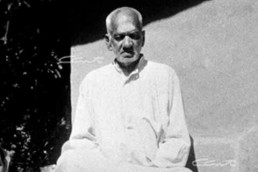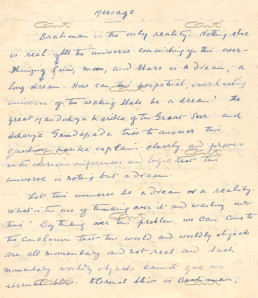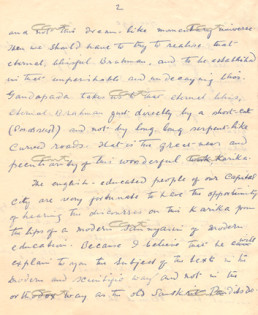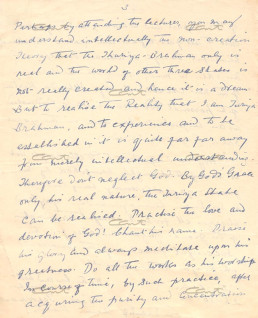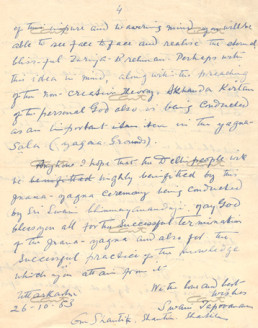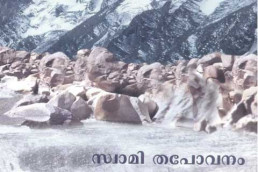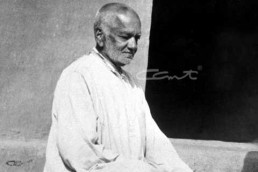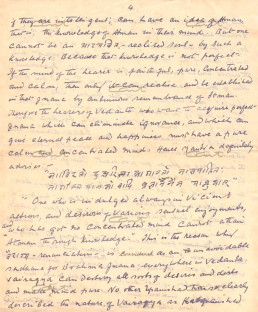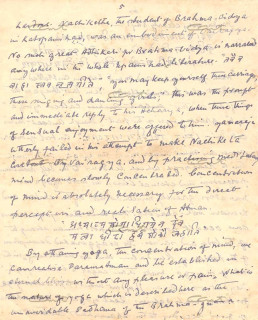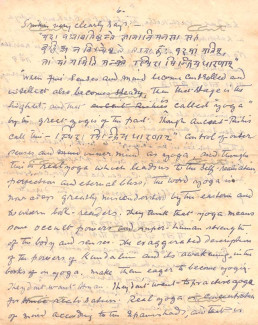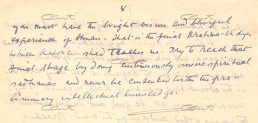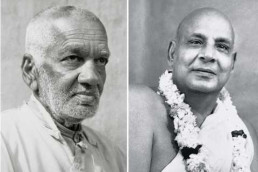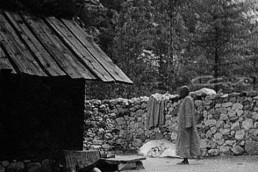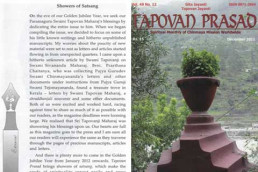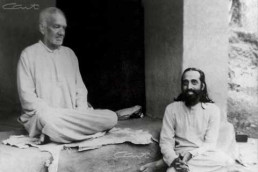Mandukya Upanishad
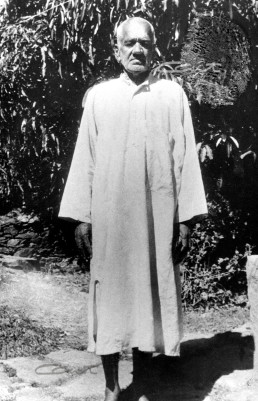
By Swami Tapovanam
This message dated 26th October 1953 was sent by Swami Tapovan Maharaj to our Pujya Gurudev, Swami Chinmayananda, on the occasion of his jnana yajna on Mandukya Upanishad which was held in Delhi from September 12 to December 10, 1953 at Karol Bagh in Delhi. Swamiji mentions the Delhi audience at the end of the message.
This message in print form is included in the beginning of the Mandukya Upanishad book published by Central Chinmaya Mission Trust. Our thanks to Smt. Leela Nambiar for giving us permission to reproduce this content here.
Message
Swami Tapovan Maharaj
(Here below we reproduce a divine message of blessings and encouragement received at the time of the Gyana-Yagna in the year 1953 from H. H. Sree Swami Tapovanamji Maharaj of Uttarakasi (Himalayas), at whose feet Swami Chinmaya learnt the scriptures-Ed.)
Brahman is the only reality. Nothing else is real. All the Universe, consisting of this ever-shining sun, moon and stars, is a dream – a long, long dream. How can this everlasting Universe perceived in the waking state be a dream? In the great Mandukya Karika the illustrious Seer and Acharya Shri Gaudapada tries to answer this question. The Karika explains clearly and proves with various inferences and logic that this Universe is nothing but a dream.
Let this Universe be a dream or a reality. Of what use is it to us to think over it and waste our time? By thinking over this problem, we can certainly come to the conclusion that this world and worldly objects are all momentary and not real, and such momentary worldly objects cannot give us Eternal Bliss. Eternal Bliss is Brahman, and not this dream-like momentary Universe.
Then we should try to realise that Eternal, Blissful Brahman, and to be established in that imperishable and undecaying Bliss. Gaudapada takes us to that Eternal Bliss, Eternal Brahman, by the most direct short-cut –as an arrow flies–and not by the serpentine, twisting path. That is the greatness and peculiarity of this wonderful work, Karika.
The English-educated people of our Capital city are very fortunate to have the opportunity of hearing the discourses on this Karika from the lips of Swami Chinmayananda, a modern Sanyasi of modern education. I believe that he will explain to you the subject of the text in the modern and scientific way and not in the orthodox way as the old Sanskrit Pundits do.
Perhaps, by attending the lectures, you will understand intellectually the non-creation theory. You may feel intellectually convinced that the Thuriya-Brahman alone is Real and that the world of the other three states is not really created and hence it is a long, long dream. But to realise the Reality as “I am Thuriya-Brahman” and to experience It, and to get established in It, is quite far far away, from a mere academic understanding of the Vedanta.
Therefore don’t neglect God. By God’s Grace alone can His Real Nature, the Thuriya state be realised. Practise the love and devotion to God. Chant His name. Praise His glory and always meditate upon His greatness. Do all the works as a worship unto Him. In course of time, by such practice, after acquiring the purity and concentration of this impure and wavering mind, you will be able to see face to face and realise the Eternal, Blissful, Thuriya-Brahman. Perhaps it is with this idea in mind that along with the preaching of the non-creation theory, the Akhanda Kirtan of the personal God is also being conducted as an important item in the Yagna Sala (Yagna grounds).
Anyhow I hope that the Delhi people will be highly benefited by this Gyana Yagna ceremony, now conducted by Shri. Swami Chinmayanandaji. May God bless you all for the successful termination of the Gyana Yagna and also for the successful practice of the Knowledge which you attain from it.
With love and best wishes,
Swami Tapovanam
UTTARKASHI
26th October 1953.
Om Shantih Shantih Shantih
Previous Topic
Nothing found.
Next Topic
Nothing found.
Related Topic
Nothing found.
Tapovanam-The Hermit Poet
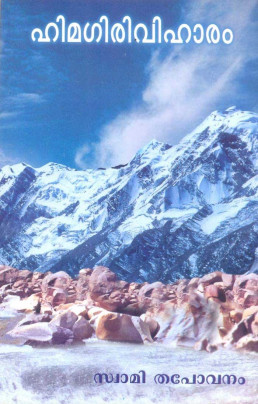
T.N.K Pillai
Sri T.N. Kesava Pillai was the person who translated Swami Tapovanam’s Malayalam book Himagiri Vihar into ‘Wanderings in the Himalayas‘ as we know it today. He also translated the Sanskrit book Ishwara Darshanam from its Malayalam translation done by Swami Mridananda of Sri Ramakrishna Ashram, Vilangan. We are very happy to reproduce this article in which he shares some of the insights he gained in the process of translating Himagiri Vihar.

By T.N.K Pillai
Sri T.N. Kesava Pillai was the person who translated Swami Tapovanam’s Malayalam book Himagiri Vihar into ‘Wanderings in the Himalayas‘ as we know it today. He also translated the Sanskrit book Ishwara Darshanam from its Malayalam translation done by Swami Mridananda of Sri Ramakrishna Ashram, Vilangan. We are very happy to reproduce this article in which he shares some of the insights he gained in the process of translating Himagiri Vihar.
Books are written with different motives. Some are composed for fame; some are written for money; a few others are written for the edification of the soul. To the last class belongs His Holiness Swami Tapovanamji’s Himagiri Vihar.
As the title suggests, it is a book of travels. But a cursory glance at its contents is enough to reveal that it is much more than an account of explorations. Swamiji’s rambles among the Himalayas form its framework, but it is only a framework. Its main contents are the spiritual experiences of a holy life devoted solely to the pursuit of Truth. The book does not belong to the class of modern travelogues, full of interesting, but superficial information, for it was not designed to cater to the idle curiosity of multitudes. It cannot be classed even with the thrilling descriptions of mountaineering adventures like The Epic of Mount Everest or Eric Shipton’s Upon that Mountain. The approach is different; the treatment is different; the basic idea itself is different.
To the Hindus, the Himalayas are not just a row of mountains forming an impregnable fortress along the northern border of their beloved motherland. It is for them the home of spirituality. In a sense, the Himalayas are to the Hindus what Olympus was to the ancient Hellenes. From immemorial times, the Himalayas have been the retreat of our Rishis who renounced the world at a ripe age and withdrew into a life of serene contemplation. Like a lode-stone, Himalaya has drawn to its bosom spiritual aspirants from all parts of the country, generation after generation. It is therefore no wonder that a spiritual genius like Swami Tapovanamji Maharaj was drawn to it irresistibly in the very prime of his life.
Swamiji was hardly thirty-four when he took up his abode in the Himalayas about thirty-four years ago. Until he entered mahasamadhi just twelve months back, he passed his days there in study and meditation, now teaching apt pupils, now treading through dangerous forests and still more dangerous snow fields, scaling steep mountains and descending into deep gorges and visiting places of pilgrimage like Kailas, sometimes again and again. His strange and wonderful experiences during these journeys and the lofty thoughts that suggested themselves to him from day to day during his perambulations are embodied in splendid language in his unique book, Himagiri Vihar.
Unlike most of his learned works like Ishwara Darshan and Saumyakaseesa Stotram, Himagiri Vihar is written in his mother tongue, Malayalam. The first part of the book saw light in book form sixteen years ago. It contained accounts of his visits to Rishikesh, Uttarkasi, Yamunotri, Gangotri, Kedarnath, Badrinath and Saradapeetham in Kashmir. The second book, published two years later, describes Swamiji’s visit to Amarnath, Jwalamukhi, Lake Reewal, Manikarnika, Vasishtha, Triloknath, Pashupatinath, Chandananath, Khocharanath, Lake Manasa and Kailas. The last volume deals with Dolingamadham, Kailas (second visit), Manasa, and Sree Gomukham. All the three volumes manifest the author’s Wordsworthian love of Nature and Man and his matchless power of description. As in the Ode to Tintern Abbey, his descriptions often shade off into the infinite and he enters into the blessed mood described by Wordsworth:
“In which the burden of the mystery,
In which the heavy and weary weight
Of all this unintelligible world
Is lightened – the serene and blessed mood,
In which the affections gently lead us on
Until, the breath of this corporeal frame
And even the motion of our human blood
Almost suspended, we are laid asleep
In body, and become a living soul;
While with an eye made quiet by the power
Of harmony and the deep power of joy,
We see into the life of things.”
In the course of this mystic experience, he felt like the poet:
“A sense sublime
Of something far more deeply interfused,
Whose dwelling is the light of setting suns
And the round ocean and the living air,
And the blue sky and in the mind of man;
A motive and a spirit that impels
All thinking things, all objects of all thought,
And rolls through all things.”
There was only one difference but how important between them. In the case of Wordsworth, as youth vanishes and he becomes a man, “the vision splendid” “fades into the light of common day”. In the case of Swamiji, on the contrary, the vision grows clearer and clearer as the years roll on, and the differences between Man and Nature and God fade away and they all merge into One without a second.
Swamiji’s descriptions are extremely vivid. Often they reach the sublimity of Miltonic poetry. The author appears to be a poet turned hermit. As for the narratives, they are as interesting as a novel and as thrilling as a drama. The thoughts interspersed among them are like sparkling gems set in flowers of gold.
Swamiji’s style is not simple; it could never be. The loftiness of his language is the loftiness of thought and they cannot be divorced without damage to both. Though he knew English and was acquainted with Western philosophy, his thoughts were formed in the Sanskrit mould. For, he was at home more in the language of the Vedas than even in his mother tongue. Himagiri Vihar is an asset to any language; it is specially so to Malayalam.
Previous Topic
Nothing found.
Next Topic
Nothing found.
Home Page
Nothing found.
Kathopanishad Message

By Swami Tapovanam
The eight-page message below was sent by Swami Tapovan Maharaj to our Pujya Gurudev, Swami Chinmayananda, on the occasion of his jnana yajna on Kathopanishad which was held in Delhi from September 26 to November 26, 1954. It can be seen clearly that the word ‘Divine’ in the title of the Message and the writer’s name below it – ‘Sadguru Sree Swami Thapovanji Maharaj’ – have been added by Pujya Gurudev in black ink.
This message in print form is included in the beginning of the Kathopanishad book published by Central Chinmaya Mission Trust. Our thanks to Smt. Leela Nambiar for giving us permission to reproduce this content here.
Message Divine: Two words on Kathopanishad
Swami Tapovan Maharaj
Kathopanishad is perhaps the clearest of all the ten classical Upanishads. Upanishad means Brahma Vidya, that is, the knowledge of Brahman. Katha explains Brahma Vidya most clearly, most vividly, and repeatedly without making the subject complicated by mixing upasanas with it as almost all the other Upanishads do. It goes on with only the descriptions of the pure Atman, which is Brahman, the only Reality. The root cause of all the miseries and calamities of this world is ignorance of Atman — avidya. By instinct or by intellect a man thinks that he is the body. This is ignorance. “Body cannot be the meaning of ‘I’. I am Atman – ever-shining, ever-lasting, eternal, pure Consciousness.” To understand Atman in such a way by intellectual thinking and discrimination, and to experience it by clear perception and realisation, is called knowledge. This Atmic Knowledge – this Atma Vidya – is asked for by Nachiketa, and Yamaraja explains it in a simple style with different methods in the whole text.
स मोदते मोदनीयँ हि लब्ध्वा
sa modate modanīyam̐ hi labdhvā
Having attained the blissful Atman, he becomes happy.1
Atman is eternal bliss. The only source of happiness is Atman. And that Atman is one’s own Self. It is already attained. Therefore, its attainment is nothing but to know it. It is not to be attained or enjoyed from outside as an object, like a mango or an apple fruit. Atman, the pure chaitanya, is ever-luminous in all its glory in this body. A man of ignorance does not know it, though he is doing all his actions by that chaitanya, Therefore, Mother Sruthi says with wonder and sorrow:
उत्तिष्ठत जाग्रत प्राप्य वरान्निबोधत ।
uttiṣṭhata jāgrata prāpya varānnibodhata |
Arise, Awake! Sitting at the feet of Mahatmas, the realised souls, know it! Realise it!2
Such knowledge of Atman, the destroyer of ignorance, is being discussed again and again in the Kathopanishad and can be obtained by an intelligent and faithful aspirant who is hearing and studying it. The knowledge “I am eternal and ever-blissful Brahman. I am beyond this body, senses and mind” which a man acquires by simply hearing the Upanishad, cannot be perfect, and therefore, would produce no great result. Incessant flow of Atmic remembrance in the mind that “I am the pure, blissful, birthless and deathless Atman,” like the continuous flow of the waves of Ganges water is called perfect jnana which alone can destroy avidya and give perpetual peace. Even an ekka-driver who attends a Vedantic lecture on the roadside can have the knowledge of Atman for a moment. Though he hears that he is Atman, he cannot think of it in the next moment, as his mind is deep-rooted in the body and body-idea. Atmic idea and knowledge have no place in his mind. His greedy and lustful mind with hundreds of desires, hatreds, ambitions and anxieties cannot think of the Atman continuously even for a few moments without having the body-consciousness, “I and mine”. It burns and boils in the waters of trishna3. Atman can be thought of, realised and remembered only by a calm, quiet and concentrated mind and not by a greedy, anxious and wavering mind.
If those who hear the discourses on the Kathopanishad are intelligent, they can have an idea of Atman, that is, the knowledge of Atman in their mind. But one cannot be an atmavit — a realised soul – by such a knowledge, because that knowledge is not perfect. If the mind of the hearer is faithful, pure, concentrated and calm, then only it can realise and get established in that jnana by continuous remembrance of the Atman. Therefore, the hearers of Vedanta who want to acquire perfect jnana, which can eliminate ignorance and which can give eternal peace and happiness, must have a pure, calm and concentrated mind. Hence the Mantra definitely advises:
नाविरतो दुश्चरितान्नाशान्तो नासमाहितः ।
नाशान्तमानसो वापि प्रज्ञानेनैनमाप्नुयात् ॥
nāvirato duścaritānnāśānto nāsamāhitaḥ |
nāśāntamānaso vāpi prajñānenainamāpnuyāt ||
One who is indulged always in vicious actions, and desirous of various sensual enjoyments, and who has got no concentrated mind cannot attain Atman through knowledge.4
This is the reason why vairagya – renunciation — is considered as an unavoidable sadhana for Brahma Jnana everywhere in Vedanta. Vairagya can destroy all sorts of desires and dirt and make the mind pure. No other Upanishad has so clearly described the nature of vairagya as Kathopanisad has done. Nachiketa, the student of Brahma Vidya in Kathopanishad, was an embodiment of vairagya. No such great adhikari for Brahma Vidya is narrated anywhere in the whole Upanishad literature.
तवैव वाहास्तव नृत्यगीते ॥
tavaiva vāhāstava nṛtyagīte ||
You may keep yourself these carriages, these singing and dancing girls.5
This was the prompt and immediate reply to his Acharya, when these things of sensual enjoyment were offered to him. Yamaraja utterly failed in his attempt to make Nachiketa covetous. By vairagya, and by practising meditation, mind becomes slowly concentrated. Concentration of mind is absolutely necessary for the direct perception and realisation of Atman.
अध्यात्मयोगाधिगमेन देवं मत्वा धीरो हर्षशोकौ जहाति ॥
adhyātmayogādhigamena devaṃ matvā dhīro harṣaśokau jahāti |
By attaining Yoga, the concentration of mind, one can realise Paramatma and be established in eternal bliss without any pleasure or pain. 6
What is the nature of the yoga which is described here as the unavoidable sadhana for the Brahma Jnana? Sruthi very clearly says:
यदा पञ्चावतिष्ठन्ते ज्ञानानि मनसा सह ।
बुद्धिश्च न विचेष्टते तामाहुः परमां गतिम् ॥
yadā pañcāvatiṣṭhante jñānāni manasā saha |
buddhiśca na viceṣṭate tāmāhuḥ paramāṃ gatim ||
When the senses and mind become controlled and the intellect also becomes steady, then that stage is the highest, and that is called ‘yoga’ by the great yogis of the past.7
Though ancient Rishis call this sthiramindriyadharanam– control of outer senses and inner mind – as yoga, and though this is real yoga which leads us to Self-realisation, perfection and eternal bliss, the word yoga is now-a-days greatly misunderstood by the Eastern and the Western book-readers. They think that Yoga means some occult powers and super-human strength of the body and senses. The exaggerated descriptions of the power of Kundalini and its awakening in the books on yoga, make them eager to become yogis. They don’t want Atman. They don’t want to practise yoga for Atmic realisation. Real Yoga is concentration of mind, according to the Upanishads, and that is to be practised and attained by a spiritual aspirant.
As there is no possibility of realising the Atman without vairagya, and without concentration of mind, every aspirant must try to acquire it at any cost. This is what the above mantra in Kathopanishad means to say. Therefore, first of all, be good, do good actions as the worship of God, and purify the mind. Practise upasana also, that is, do japa and meditation on a personal God. By practising this selfless service and upasana, the wavering state of mind will perish, and mind will become gradually purified. Then you will be able to realise undoubtedly the Atman, and to live as Atman, which you have intellectually understood by attending the discourses on Kathopanishad.
Never be satisfied by simply attending and hearing the Vedantic discourses. Intellectual knowledge of the Atman is only the first stage; don’t think that it is the last and the final stage. Many ladders you have to climb on after the acquisition of this intellectual knowledge, if you must have the bright vision and the blissful experience of Atman. That is the final Brahma Vidya which the Kathopanishad teaches us. Try to reach that final stage by doing continuously severe spiritual sadhanas and never be contented with the preliminary intellectual knowledge.
1 Kathopanishad, 1.2.13
2 Kathopanishad, 1.3.14
3 Thirst for things
4 Kathopanishad, 1.2.24
5 Kathopanishad, 1.2.26
6 Kathopanishad, 1.2.12
7 Kathopanishad, 2.3.10
Previous Topic
Nothing found.
Next Topic
Nothing found.
Home Page
Nothing found.
Para Bhakti
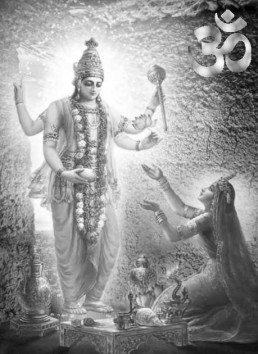
By Swami Tapovanam
English Translation by Swami Chinmayananda
This is an excerpt from the final portion of the tiny book titled ‘Glory of Brahma Vidyā’ published by the Central Chinmaya Tapovan Trust. It was originally written in Sanskrit by Sri Swami Tapovanam for the Vedanta volume of ‘Kalyan’ and was later translated into English by Pujya Gurudev Swami Chinmayananda and published serially in Tapovan Prasad from July to September 1968. Then it was brought out in book form. Since very few people know about its existence, we are publishing an excerpt here.

By Swami Tapovanam
English Translation by Swami Chinmayananda
This is an excerpt from the final portion of the tiny book titled ‘Glory of Brahma Vidyā’ published by the Central Chinmaya Tapovan Trust. It was originally written in Sanskrit by Sri Swami Tapovanam for the Vedanta volume of ‘Kalyan’ and was later translated into English by Pujya Gurudev Swami Chinmayananda and published serially in Tapovan Prasad from July to September 1968. Then it was brought out in book form. Since very few people know about its existence, we are publishing an excerpt here.
Knowledge is of two kinds – parā and aparā. The Vedas give aparā knowledge, because as a science, it talks of the knowledge of things; here knowledge illumines only limited objects, and this can give rise only to knowledge of the finitude – saṁsāra — and its endless experiences of attachments, hatreds etc. The Infinite-thought (akhaṇḍākāra vṛtti) rising as a result of the practice of Brahma Vidyā is called the parā knowledge. This awakes in us the experience of the infinite Reality and completely annihilates all the finite experiences of the world-of-objects (saṁsāra). Thus Vedānta Vidyā is the highest knowledge and the greatest science in every sense of the term – in its techniques, in its final goal, and in its own very nature. This is the chorus declared by all Rishis in the Vedānta text books.
That which is called as Parā Vidyā in Vedanta volumes is itself the condition of Parā Bhakti as discussed in books of devotion. Devotion is of two kinds – the path (sādhana rūpā) and the goal (phala rūpā). A close examination of and the consequent discrimination between the Lord and the devotee, between ‘That’ (tat) and ‘You’ (tvam) terms in the Mahāvākya generates a force of meditation which culminates in the experience of the Lord – the pure Brahman, the Absolute. Thereafter alone can the goal, the Parā Bhakti dawn in the bosom for experience. Thus the Parā Bhakti, pure devotion, which springs from the experience of the pure Self is in no way less than Brahma Vidyā. This explains why Sri Madhusudana Saraswati considered Parā Bhakti as the sixth stage (bhūmikā) in the 11-stage spiritual scheme of unfoldment discussed by him in his work ‘Bhagavad Bhakti Rasayanam’.
In this work, Madhusudana rightly uses the pregnant term svarūpādhigatistataḥ . The experience of the pure Brahman, the ever- pure (nirviśeṣa), the formless (nirākāra), the essence (svarūpa bhūta), as nothing other than the Self within is pure devotion – Parā Bhakti. This state is considered as one of the higher stages in the ladder of evolution towards the highest divine experience.
The seeker whose heart is rich in pure love — even if he be a person who has realised the Truth — comes to express his devotion to one of the many manifestations of the glory of the Self. He comes to court and feel his oneness with the divine in the forms of Siva, Vishnu, Rama or Krishna. This experience of perfection and the practice of Parā Bhakti makes him the best teacher of the world (Jagadguru) and he gets the gratitude of seekers in all generations. His is the true glory; he alone is the true teacher, the prophet.
The experiences of a student of Brahma Vidyā are also the experiences of a Parā Bhakta. The sacred Parā Bhakti is nothing other than the Parā Vidyā.
The infinite Saccidānanda Brahman to be ultimately realised through the science of Vedanta is both without form (nirākāra) and also with form (sākāra). The whole universe of names and forms is the glory of the Supreme only. Thus devotion to this divine form is advised and it should be practised. This is not an opinion; it is declared in the very Upanishads by the Rishis themselves.
यथा सर्वगतस्य निराकारस्य
महावायोश्च तदात्मकस्य त्वक्पतित्वेन
प्रसिद्धस्य साकारस्य महावायुदेवस्य
चाभेद एव श्रूयते सर्वत्र तद्वत् परब्रह्मणः
सर्वात्मकस्य साकारनिराकारभेदविरोधो
नास्त्येव॥
yathā sarvagatasya nirākārasya
mahāvāyośca tadātmakasya tvakpatitvena
prasiddhasya sākārasya mahāvāyudevasya
cābheda eva śrūyate sarvatra tadvat parabrahmaṇaḥ
sarvātmakasya sākāranirākārabhedavirodho
nāstyeva..
Air that is everywhere and at all times, can be comprehended by us only when the breeze comes and touches our skin. It assumes the nature of existence to us, but its pervasiveness is not minimised thereby. Similarly, Brahman, the infinite and eternal, even when worshipped with a form, cannot be contaminated by the limitations or attributes so superimposed upon it (because of the form). It is ever all pervasive, absolute and immortal. 1
त्रिलोचनं नीलकण्ठं महान्तं
ध्यात्वा मुनिर्गच्छति भूतयोनिं
umāsahāyaṃ parameśvaraṃ prabhuṃ
trilocanaṃ nīlakaṇṭhaṃ mahāntaṃ
dhyātvā munirgacchati bhūtayoniṃ
The Rishis, meditating upon the form of three-eyed Parameshwara accompanied by Uma, enter into Him and become one with Him. 2
śraddhā-bhakti-dhyānayogādavaihi
Know that eternal Truth through faith, devotion and meditation. 3
yasya deve parā bhaktiryathā deve tathā gurau
tasyaite kathitāhyarthāḥ prakāśante mahātmanaḥ..
One who has supreme devotion – Parā Bhakti – unto Parameshwara and to his own Guru, in him alone Truth comes to shine.4
2 Kaivalyopanishad, 1.7
3 Kaivalyopanishad, 1.2
4 Shvetashvatara Upanishad, 6.23
Previous Topic
Nothing found.
Next Topic
Nothing found.
Home Page
Nothing found.
Real Bhava in Service
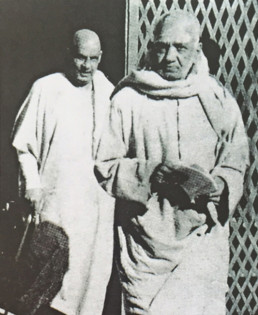
By Swami Tapovanam
In honor of Swami Sivananda
All of us are familiar with the beautiful article ‘Sri Swami Tapovanam: An Embodiment of Ideal Sannyasa’ written in November 1947 by Swami Sivananda Maharaj, but hardly anyone knows about this wonderful article written in September of the same year by Swami Tapovan Maharaj, on the occasion of the sixtieth birthday of Sri Swami Sivananda Maharaj. He writes about Swami Sivananda – ‘I know him; I love him; and I have been looking at his activities and progress with a gladdening heart for the last so many years. We are very closely connected with each other by mutual love and respect.’
Swami Padmanabhananda, the General Secretary of the Divine Life Society, unearthed it from an old souvenir and published it in their magazine The Divine Life in the September 2011 jayanti issue. And he was kind enough to grant us permission to reproduce it here. I am sure all our readers will enjoy this article that brings out the close friendship and mutual reverence between two great Mahatmas, the Diksha Guru and the Vidya Guru of our Gurudev, Swami Chinmayananda.

By Swami Tapovanam
In honor of Swami Sivananda
All of us are familiar with the beautiful article ‘Sri Swami Tapovanam: An Embodiment of Ideal Sannyasa’ written in November 1947 by Swami Sivananda Maharaj, but hardly anyone knows about this wonderful article written in September of the same year by Swami Tapovan Maharaj, on the occasion of the sixtieth birthday of Sri Swami Sivananda Maharaj. He writes about Swami Sivananda – ‘I know him; I love him; and I have been looking at his activities and progress with a gladdening heart for the last so many years. We are very closely connected with each other by mutual love and respect.’
Swami Padmanabhananda, the General Secretary of the Divine Life Society, unearthed it from an old souvenir and published it in their magazine The Divine Life in the September 2011 jayanti issue. And he was kind enough to grant us permission to reproduce it here. I am sure all our readers will enjoy this article that brings out the close friendship and mutual reverence between two great Mahatmas, the Diksha Guru and the Vidya Guru of our Gurudev, Swami Chinmayananda.
ब्रह्मैवेदममृतं पुरस्ताद्ब्रह्मपश्चात् ब्रह्म दक्षिणतश्चोत्तरेण।
अधश्चोर्ध्वं च प्रसृतं ब्रह्मैवेदं विश्वमिदं वरिष्ठम्॥
brahmaivedamamṛtaṃ purastādbrahmapaścāt brahma dakṣiṇataścottareṇa.
adhaścordhvaṃ ca prasṛtaṃ brahmaivedaṃ viśvamidaṃ variṣṭham..
Verily, all this is the immortal Brahman above, below, in front, at the back, on the right, on the left. It is everywhere. All this world is indeed the supreme Brahman. 1
आत्मैवेदं समिति ॥
ātmaivādhastādātmopariṣṭāt ātmāpaścā- dātmā purastādātmā dakṣiṇata ātmottarata
ātmaivedaṃ samiti..
The Self indeed is below, the Self is above, the Self is behind, the Self is in front, the Self is in the south, the Self is in the north, the Self indeed is all this. 2
āścaryamadya mamabhāti kathaṃ dvitīyaṃ nitye nirastanikhilāśiva citprakāśe..
After realising the Self, it is a wonder to me how in the eternal light of Consciousness which is devoid of all impurities, anātmā which is impermanent, full of impurities, and insentient, appears at all! 3
Realisation of this Upanishadic truth is the aim of human life. This sarvātma bhāva – this advaita bhāva – is the root cause of all the divine qualities which are the foundation of The Divine Life. Divinity and unselfishness can be attained only by this sarvātma bhāva. Without having attained this sarvātma bhāva, the qualities of love, modesty, generosity, equality and service etc. become selfish, narrow and momentary. No perfection, no peace, no joy and no jivan-mukti can be attained without this sarvātma bhāva.
ātmanaḥ pratikūlāni pareṣāṃ na samācaret.
That which is not good for oneself should not be done unto others. 4
This advice of the great law-maker, Manu, also can be practiced fully and perfectly only by those wise men who have realised this sarvātma bhāva. And only these realised souls are really entitled to teach and preach divine qualities and divine life to others, because the world is benefitted only by the teachings of such religious teachers who speak as they have realised and practised. Now-a–days even those who have no faith in God pose to be the devotees and seers of God and preach about God, God-realisation and godly qualities. A greedy man preaches renunciation, a haughty man advices modesty, and an idol of hatred becomes the teacher of love. That does more harm than good to the society. And killing the conscience is always more sinful than the killing of many brahmins and cows. Not only wise men, but God also laughs seeing the drama of such spiritual masters.
Go to Ananda Kutir at Rishikesh. You can see an embodiment of this sarvātma bhāva there, who deserves to be the real and great master of divine knowledge, divine qualities and divine life. I mean Srimat Swami Sivananda, the widely known and respected sage of the present age. His love and modesty have no bounds, because they are derived from the real sarvātma bhāva. Though he is a sannyāsi of the best type, of great tyāga and vairāgya, his love made him a man of service. Love never makes a man sit quiet before the troubles and miseries of his brothers. I quote an incident of his great love described in my Sanskrit book Ishwara Darshan from my own experience.
“Once, when Swamiji (Tapovanji) was residing somewhere below Brahmanandashrama, Sri Sivanandaji came to him one day at noon and said in English, “A Bengali sadhu is residing with me. For the last few days he has been very ill. Just to give him, I want a little milk. I have been going from ashram to ashram for a few ounces. But it has not been available. There is no way to get it except on payment from some shop. If only I had two annas!” Sri Tapovanji too had been depending entirely on bhiksha. He kept no pie of his own. Yet, somehow, he managed to get four annas and with humble prostrations, handed it over to Swami Sivananda, praising his great kindness and love of service. Swamiji whole-heartedly admired and respected Swami Sivananda for his loving acts of kindness and noble qualities.”
There was not a single pie kept by him at that time. Mark his burning spirit of renunciation! Yet, in that virakta stage also, he wanted to serve others. See his burning love and sympathy towards the sick and helpless. His modesty also is unparalleled. Though he has taken birth in an ancient orthodox and proud brahmin family of South India, he does not hesitate even to take the dust of the feet of the non-brahmin householders. Such modesty can rarely be seen even in the mythological Rishis of yore.
I know him; I love him; and I have been looking at his activities and progress with a gladdening heart for the last so many years. We are very closely connected with each other by mutual love and respect. Both of us are sons of South India, the mother of so many world-renowned saints, philosophers and acharyas. Both of us came to Rishikesh as sannyāsins and began our Himalayan tapaścarya almost at the same period. But afterwards, I began to live in the caves of Badrinath and Gangotri — I don’t know why, but I liked it. He preferred to stay on at Rishikesh itself and stuck to his tapasyā there, and in course of time, became a great master of divine life by his spiritual attainments and activities.
I have not written these lines to praise him. I have written these lines simply to record my admiration towards his perfect sarvātma bhāva, the mother of all his divine qualities. I think that this great quality is the secret of his success in spiritual life. When I remember Swami Sivanandaji, this great quality of that great saint comes to my remembrance more readily than his learning, authorship, religious leadership and all other uncommon qualities and activities.
Now, all over the country, the sastyabdapūrti day of this great spiritual genius is being celebrated by his disciples, friends and admirers. I remember him with a loving and respectful heart, and send him my greetings in the form of these Sanskrit ślokas on this auspicious occasion, sitting here in the solitude of my Himalayan hut, because I know he loves and respects the Sanskrit language naturally by instinct. Why not? He is the descendant of a highly famous and unrivalled Sanskrit scholar Maha Mahopadhyaya Sri Appayya Deekshitar. I quote here one incident of my life from my remembrance in connection with Appayya Deekshitar for the amusement of the readers. When I was studying ‘Kuvalayānanda’, an alaṅkāra (rhetorical) work of Appayya Deekshitar, at the early age of 17 or 18 in my house at Malabar, I put the question to the preceptor Shastri: “Who is this Appayya Deekshitar, the writer of such a beautiful and majestic work, ‘Kuvalayānanda’?” Shastriji could not answer the question, because he was completely ignorant of the life of Deekshitar. He was ashamed. The incident passed off. Though I could not get any knowledge at that time about his life, great admiration and respect towards his great Sanskrit learning and scholarship was produced in my mind. That Appayya is the forefather of our beloved Sivanandaji. This piece of information has given me immense joy and wonder, and now also gives me whenever I remember that.
2 Chhandogya Upanishad, 7.25.2
3 Sankshepa Sariraka, 4.57
4 Mahabharata, 5.15.17
Previous Topic
Nothing found.
Next Topic
Nothing found.
Home Page
Nothing found.
The Glory of Sri Gangottari
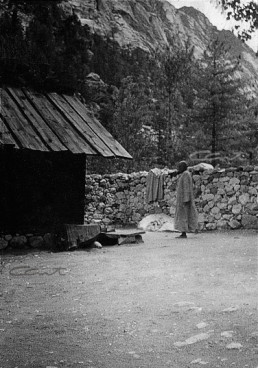
The Glory of Sri Gangottari
This is a free-flowing translation of the 108 verses in the first part of Gangottari Mahatmyam or ‘The Glory of Sri Gangottari’ by Sri Swami Tapovan Maharaj. These days many people go on a Char Dham Yatra and visit Gangottari. Their pilgrimage will be enriched by reading this outpouring by our Parama Guru Swami Tapovan Maharaj. The beauty of the Sanskrit verses can never be fully captured in English. And yet, for those of us who are not familiar with Sanskrit, this eminently readable article will at least give a glimpse of what our Swami Tapovanam has written.

The Glory of Sri Gangottari
This is a free-flowing translation of the 108 verses in the first part of Gangottari Mahatmyam or ‘The Glory of Sri Gangottari’ by Sri Swami Tapovan Maharaj. These days many people go on a Char Dham Yatra and visit Gangottari. Their pilgrimage will be enriched by reading this outpouring by our Parama Guru Swami Tapovan Maharaj. The beauty of the Sanskrit verses can never be fully captured in English. And yet, for those of us who are not familiar with Sanskrit, this eminently readable article will at least give a glimpse of what our Swami Tapovanam has written.
Once upon a time, in the huge assembly of Brahmaloka, graced by Lord Brahma (the creator) and other gods, and sages like Sanaka, there arrived Narada Muni, singing the glories of Gangottari and its magnificent beauty. Singing thus, accompanied by his melodious lute, he bowed down to the four-faced Lord Brahma with great devotion.
Brahmaji welcomed him and enquired about his welfare: “Please come and be seated here. I am seeing you after a long time. Hope all is well with you. Tell me about all the places you have visited in this time.”
Narada replied, “Roaming here and there in many worlds, finally I reached Gangottari, situated among the snowy peaks of the Himalayas. Covered with splendid forests and stately trees, arrayed with exotic flowers, the divine place resounded with the enchanting chirping of a variety of birds. Here it was that the river Ganga, originating from the holy feet of Lord Vishnu, descended from the heavenly regions and made herself visible to the eyes of human beings. Here shines the famous and sacred Bhagiratha Shila, on which Bhagiratha, the best among kings, stood in intense tapas for long. Having bathed in the holy Ganga there, and having worshipped her devoutly with a thousand names, I have come to you straight, singing the glories of Gangottari, the most excellent among holy places.”
Lord Brahma responded: “Blessed are you, O Sage! Having worshipped at the holy Gangottari tīrtha, your life is fulfilled forever. The place where Bhagiratha performed his penance is well-known in the three worlds. O Narada, know this sacred place to be a veritable Vaikuntha on Earth. There is no other place to match this in bestowing both prosperity and liberation. It is free from the evils of Kaliyuga and is the recreation ground of the holy Ganga. Hundreds of Śivaliṇgas and images of various deities are found here in abundance. Those pilgrims who visit this holy place and worship are indeed blessed, as it gives rise to pure sattva-guṇa. What a wonder that there is no sin, no corruption, no crookedness, no deceit, no hypocrisy, nor any sorrow here! It is a place of penance for ascetics and of contemplation for sages; it is the beloved abode of devotees and dispassionate ones. Rich it is with fruits, roots and tubers, endowed with many caves and thickets, serene, secluded and profound, a place fit for brahma-samādhi.”
“O Sire,” said Narada, “please tell me in detail the greatness of Gangottari and also how this name came about. O Grandsire of the entire world! Please tell me about the important places there that should be visited and worshipped. I wish to listen to all this directly from you, for who else except you knows it all!”
Lord Brahma said, “Well asked, O Sage! Listen to my words now. I shall tell you in brief about this holy secret that you have queried. The greatness of Gangottari is wondrous and awe-inspiring. It is not easily available even to gods. It should be guarded with great care. All kinds of people have obtained their desires and attained liberation by worshipping this holy place. It is well known that in Kaliyuga, when the minds of people are tainted by its typical flaws and laziness, there is no other means of attaining prosperity and liberation than the worship of the holy Ganga.”
“Even a glimpse of the holy Ganga is meritorious, so also a dip in her waters, living on her banks, chanting of her name and worship offered to her. Even a touch of the breeze sanctified by her waters can wash away one’s sins. The holy Ganga is the sole refuge in Kaliyuga for sinners who want to shed their sins, for those who want to fulfill their desires, for sufferers who want an end to their sorrows and for devotees who seek final liberation.”
“Verily, the supreme Brahman alone flows in the form of the river with the auspicious name of ‘Ganga’ in order to bestow upon man all the four puruṣārthas (dharma, artha, kāma and mokşa). The greatness of Ganga is more evident in the higher reaches. So, as far as possible, we should worship her at the higher altitudes.”
“How can the glory of Gangottari, the best among holy places, the peak of the northern region and the very birthplace of the holy river Ganga ever be described?”
“Since she came down to the earth, she became known as Ganga – gāṃ gatā hi tato gaṅgā. And now, on earth, her magnificent flow and terrific speed is wondrous indeed. The place where she flows northwards (uttara) is known as Gangottari. Or, since the heavenly Ganga came down from her abode, headed towards this spot, crossing over (uttarati) the outer space etc. it is called Gangottari. Or, O Narada, the place where the northern part (uttara) of Ganga shines forth is known as Gangottari. Or, the sacred place where the blessed Ganga alone is the supreme (uttara) deity, and none else, became famous as Gangottari. Or else, being the best means of crossing over (uttaraṇam) the ocean of saṁsāra, the region is known as Gangottari.”
Bhageeratha Shila
“O Son, now listen carefully about the important places worthy of worship situated in this great location. The best among them is the Bhageeratha Shila visited by you. King Bhageeratha did intense tapas there for 5500 years, eating only dry leaves. In this long period of time, an anthill formed around him. Pleased by his severe penance, I appeared before him and granted him the boon he desired. Ganga lives there along with Yamuna and is worshipped duly. These two beautiful glowing goddesses, one fair (Ganga) and the other (dark), appeared bedecked and bejewelled, with dangling earrings, in front of Bhageeratha, the grandson of Anshuman.”
“As of yore, today also they are visible in this sacred place to those great devotees who are dedicated to their lotus feet. There is no doubt about this. They are seen wandering among the forests full of deodar trees. Adorned with earrings and jingling golden waist-bands, smiling sweetly, lotus-eyed, seated on a golden throne, surrounded by many damsels, shaded with a white umbrella, fanned by Indra and other gods, the Mother of the three worlds, not easily attained by the denizens of the three worlds, resides here always with Yamuna, the daughter of the Sun-god. The abode of Ganga and Bhageeratha’s place of penance – great indeed is the sanctity of this Gangottari. Mortals attain immortality, absolved of all their sins, by bathing in the waters of the Ganga and worshipping her at this spot.”
“O Narada! This is the best place on earth to offer oblations to the ancestors. There is no time restriction for such rituals here; one can perform them in the day or at night. Whoever performs the rituals for their ancestors here, uttering their name and gotra, those ancestors, even if they be sinful, go to heaven.
“O divine sage, listen! Whoever makes offerings in fire for devas in this place, gets special rewards. The gold, silver, cows, grains and lands which are given to brāhmaṇas in charity at this place bear fruit immediately. There is no doubt that charity and other such actions performed here are a thousand times more fruitful than in holy places like Varanasi, Gaya, Haridwar etc. Where is Gangottari and where are Kashi and Gaya! Can a glow-worm shine in front of the brilliant sun? O Muni! Great tīrthas like Kashi assume divine forms and reside in this sacred place day and night to purify themselves.”
Gauri Kunda
“Behind the Bhageeratha Shila is Gauri Kunda of great sanctity and extraordinary beauty, which is visited by gods, and a mere glimpse of which is enough to destroy all sins.”
“The place where Kedara Ganga, flowing down from the peaks of Kedarnath, mingles with Jahnavi is a hallowed place. O Muni, it is wonderful to see the Ganga cascading down as a waterfall and to hear the deep reverberation of her continual thundering roar.”
“Goddess Gauri, surrounded by her companions, sports here; hence this place is known as Gauri Kunda. Lord Siva, the consort of Gauri, the lord of the universe, the leader of celestial beings, resides here along with his bhūta-gaṇas.”
“In this sacred place setutarpaṇa is to be performed. I shall tell you the method, listen carefully. The sand brought from Dhanushkoti is to be worshipped in the prescribed way with offerings of coconuts and sanctified with the chanting of Rudram etc. and offered in the Gauri Kunda devoutly by the best of ascetics. This is called setutarpaṇa and it is very meritorious. One who does the setutarpaṇa as specified, without any desires, is released from the cycle of births. There is no doubt about it. If it is performed with a specific desire, it is fulfilled soon. Whoever does setutarpaṇa thus is blessed indeed.”
“Listen further, O Muni! The water from the Ganga in Gangottari — carried by one who is pure internally and externally, who is devout and self-controlled, who walks on foot and follows the right values, who sleeps on the ground and eats very little — offered as ordained to the Sivalinga in Rameshwaram, installed by Sri Ramachandra in days of yore and worshipped by devatās, yields the state of Śiva-sāyujya to the one who does the abhiṣeka.”
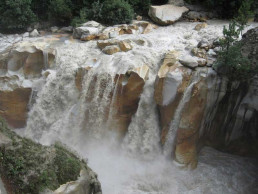
Pandava Yajña Bhūmi
“Behind the Gauri Kunda is the sacred spot where the Pandavas performed yajña. A mere glimpse of it has the power to destroy all our sorrows. Following the advice and instructions of Sri Veda Vyasa, the Pandavas came to Gangottari to atone for the sin of killing their own kin. There, with due devotion and ordained rituals, they performed a deva-yajña with the help of brāhmaṇas. What a delightful place it is, vast and undisturbed! Even today, the residual ashes from the yajña can be seen there under the earth.”
“Nearby, see the Ganga gushing down from the mountain peak where reside the eleven Rudras. The great Gurus and those who have realised the Truth have thought well about how to elevate the mind attached to worldly thoughts gradually, step by step, effortlessly, and have invoked the appropriate devatās in the tīrthas. And these Rishis themselves resided in those places and worshipped them for the welfare of the people.”
Rewards of Pilgrimage
“When worship of the fire and tapas is not performed any more in this world, how will the weak mortal attain material welfare and ultimate liberation? Selfless worship of the divine Ganga destroys the accumulated sins of many lives and gives rise to great merits. Then likes, dislikes and other flaws of the mind are removed and then devotion for the Lord and (spiritual) knowledge is born. Even those who are not qualified for it attain such devotion and knowledge effortlessly.”
“The main result of all the pilgrimage, penance, self-study, worship, singing the praise of the Lord is the attainment of liberation; others are ancillary benefits. Just as children are lured by jaggery, the dull and worldly-minded people are given specific rewards as incentives to pursue virtuous actions. All the worldly pleasures seem desirable, but wise people do not desire them because they are impermanent and tainted by sorrow. Who, except fools, will undertake arduous pilgrimages for the sake of ephemeral gains?! The only reward we seek should be to please God and gain devotion which can release us from the miseries of the world.”
“’Bhagavan is the lord of the entire world and full of compassion for the devotee; I am but a worldly jīva, an insignificant servant of His.’ With such duality in the intellect, the wise one begins worship of the Lord and attains the non-dual vision of the Lord in everything. The realisation that all is Brahman is the only actual means to liberation. Alas! Who attains it easily here? Until the continual unbroken knowledge of ‘All is Brahman,’ does not come about, the finite thought of ‘This is Brahman,’ is prescribed. ‘All this, moving and non-moving is pervaded by Īśvara,’ – such firm knowledge arises only with the practice of many lifetimes.”
“How can one who is unable to worship a gross form like a river or a stone idol worship the essential Truth of Īśvara which is subtler than the subtlest? Places endowed with natural beauty and other such fascinating things are worth seeing and contemplating upon. Holy places of pilgrimage are meant to make the mind that is extroverted and scattered among sense objects turn towards God. Even the contemplation on God with a form is difficult and hence a concrete symbol has to be given to those with a (spiritually) dull intellect. Somehow or other the roving mind that is tenaciously moving everywhere moment to moment has to be restrained and made single-pointed. Even a mind that is full of sinful thoughts should be made to entertain good thoughts through conscious effort, and then made thought-free. The Lord knows the thoughts and feelings of all people, and bestows the appropriate results to them.”
“Some people purify their hearts by adoring sacred places or worshipping deities like Rama or Krishna, others through japa, tapa, prayers or singing of hymns, yet others by self-study or contemplation on the scriptures. Some prefer to do prāṇāyāma and some others resort to meditation. Some do it by performing rituals or selfless actions, some by doing charity or service to mankind. Thus, without any desires, they worship God and purify their minds.”
“How can an impure mind agitated with hundreds of thoughts attain the state of thoughtlessness? Only a pure single-pointed mind capable of subtle thinking can come to know the highest Truth that is beyond the reach of the mind and the senses.”
Continued …
Narada Muni said, “O Brahmaji! With your grace, I have been able to hear about the incomparable and mystical glory of Gangottari. Now, O Lord, with a fatherly affection, please tell me the distinctive features of the other places in the region.”
“O Narada, listen about the other holy places, a mere glimpse of which can destroy hundreds of sins,” said Lord Brahma. “You are dear to me, you are my son, and hence I will tell you about the secret glory of these places, which are rare to find in the three worlds, and that delight the hearts of good people.”
Lakshmi Vanam, Devaghat and Bhurjavasa
“O Sage! There shines right ahead Lakshmi Vanam1, the playground of Mahalakshmi, full of fruit-bearing trees. Further ahead is the confluence of Devi and Ganga.2 This is the abode of gods, and mortals cannot reach there. To the east is the beautiful Bhurjavasa, an expansive forest full of mighty birch trees. Blessed is he who can set eyes on this divine place worshipped by celestial sages, yakşas, gandharvas, siddhas and cāraṇas.3”

Pushpavasa, Gomukha and Suryakunda
“Beyond this, O best among sages, lies the vast garden of flowers called Pushpavasa, full of many varieties of ambrosial blossoms. There is Gomukha, the hallowed birthplace of the divine Ganga, holier than the holiest on earth, extolled by sages in many hymns. It is surrounded by high snow-covered peaks almost touching the heavens and presided over by gods. In that place, bedecked with masses of snow, a veritable jewel on earth, from a deep snowy cave, shaped like the mouth of a cow, emerges with tremendous force the celestial river Ganga, to purify and bless all beings on earth. Those who manage to reach that extremely inaccessible, divine cave, and bathe in the waters of the Ganga in the prescribed manner will have no more re-birth, O Son! There need be no trace of doubt about it. Understand this, for you are very dear to me.”
“One who dips himself in the bluish waters of the famous Suryakunda in Gomukha begins to glow like the sun. The mountain ranges beyond this are perpetually covered with heavy snow and are inaccessible to human beings. Not far from Gomukha is Vishalapur4 and the route there is frequented by siddhas and devatās.”
Sri Narada Muni beseeched him thus, “O Lord of the worlds! Please describe in detail the glory of Gomukha, the birth- place of Jahnavi.”

More about Gomukha
Lord Brahma responded, “Dear Narada, listen carefully. I shall answer your query about the sublime splendour of Gomukha that should ever be cherished and guarded. Gomukha, praised by the gods, is the sportive ground of Sri Lakshmi herself. Since this cavern in the snow is shaped like the mouth of a cow, it bears the name ‘Gomukha’. Lit up on all sides by the bright snowy peaks, donning ornaments made of masses of snow, she delights the mind in the daytime with the silver sheen of the ethereal mountain peaks and in the evening with their golden glow, making one wonder whether the mountains are made of silver or gold!”
“Gomukhi is divine and spreads her ethereal effulgence all over the vast expanse of space. She shines as the central gem in the crown jewel of the Himalayas. It is a place that is worshipped by gods and is not easily attained even by them. Great is the puṇya of the virtuous ones who are able to set eyes on it. It is deep and inaccessible, and devoid of vegetation. It is supremely tranquil and profound, magnificent and carpeted with stones and pebbles.”
“To add to its beauty, there is a forest of birch trees nearby. A variety of birds of many hues chirp melodiously. Spread all around are flowers – blue, red, white and yellow, fit to adorn the locks of Indrani (consort of Indra). Musk deer and a variety of other wonderful animals roam about free and fearless.”
“Who can ever describe the exquisite beauty of the place! Even Indra with a thousand eyes never tires of looking at it. O Sage! Not merely is this place the source of joy for the senses, but it is also the crest jewel of all tīrthas (holy places of pilgrimage). By going there even once and having darśana, all one’s sins will be rooted out and one will get the desired results. At the touch of a single drop of the water of Ganga there, one attains the abode of gods, irrespective of where one lives. O Muni! Lord Vishnu, Siva, Indra and I have worshipped this tīrtha with śraddhā (total faith and dedication) many a time. When the best of seekers go there, they are irresistibly drawn by its divine beauty and get immersed in the contemplation of Brahman. Those who have analysed the matter say that the knowledge of the effect results in knowledge of the cause. Thus, by seeing the glory of Nature there, Brahman, the cause of it, comes to mind. At the sight of a magnificent palace, its architect is remembered. In the same way, seeing the awe-inspiring and divine beauty of Nature untouched by man, one remembers God, its creator. What wonder then if virtuous people get immersed there in thoughts of God?”
“Beauty is the nature, the very essence of God. And hence it is seen in Nature also. Beauty is not the essential quality of Nature by itself. Brahman, the seed of this world, is the Truth of truths, the Consciousness of all that is sentient, and the Beauty of beautiful things. Thus, through the window of Nature, Brahman alone bestows joy to all as they deserve. The wise ones who have the profound knowledge of Brahman see clearly that all this glory belongs to Brahman, and it is not Nature’s own radiance. Such wise people, overwhelmed by the divinity of such places where the beauty of Brahman shines forth, attain the supreme state of oneness with Brahman spontaneously. O Sage! Great is the merit bestowed by the darśana of Gomukha! Only a pure and blessed soul attains it.”
“The darśana of Gomukha and a holy dip there gives devotees wonderful rewards here and hereafter. What more needs to be said? Listen to this secret of secrets. There is no other tīrtha like Gomukha on this earth.”
“O best among sages! Whichever places I have described to you are all worthy of being worshipped by all mortals. Besides these, the other most blessed places that are there below, I shall describe. Listen carefully with devotion.”
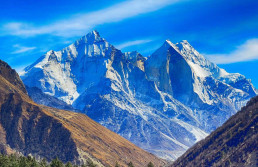
Other Places of Pilgrimage near Gomukha
“Below the Gaurikunda is the wonderful abode of Sri Bhairava. The formidable and powerful form of Sri Bhairava is to be worshipped there. Further down is the mystical and utterly charming spot where the dark-hued Jahnu Ganga joins Sri Gangaji. O best among sages! Those who go upward along the banks of Jahnu Ganga will come across many divine tīrthas that destroy their sins.”
“The actual dwelling place of Lord Siva (Mt. Kailas), darśana of which destroys the cycle of saṁsāra, is approached through this route by some people.6 O Sage! Nearby is the hermitage of Sri Jahnu Rishi, where the kingly sage performed severe penance.7 A little below this is the charming stream named Kumkum on whose auspicious banks Sri Veerabhadra resides.8 Alongside is the important place where Mahadevi Chandeshwari, the destroyer of Chanda and Munda resides. In the same region flows the delightful stream, well-known as Deva Ganga,9 which is worshipped by gods and which bestows great merit.”
“O Narada! Behind this stream, near the vast sands of the river Ganga is the place of Markandeya that is worth seeing. Matanga Rishi, the best among sages, had observed austerities for many years nearby, living only on air, and attained Realisation. While proceeding to Gangottari, Yudhishthira and the other Pandavas spent many nights there and worshipped Mother Ganga. Brought by the son of Vayu (Bheema), a big stream flows by with great force like the wind, sanctifying all in its path.10 See the wondrous imprints of the hooves of the Pandava horses on the rocks here! Only virtuous people with great merits (puṇya) can see these. This place bestows all kinds of wealth and is the stepping-stone to the supreme Truth. This is the favourite abode of Mother Ganga and is also beloved of the gods.”
“Among all the monasteries on the earth, this abode of Ganga is known to be the best.11 Meritorious deeds performed at this place where Markandeya did tapas will fetch results similar to the deeds undertaken at the place where Bhageeratha performed his penance. Actions prescribed by the sāstras, like bathing, offering oblations to the ancestors, charity etc. done here bring wonderful and desired results to those who perform them. The mere sight of the huge rock used by Sage Markandeya (for his tapas) has the power to destroy crores of earlier karmas. Distribution of food and clothes in this place is considered to be especially meritorious. Brāhmaṇas and others are to be seated on that huge rock and fed in the prescribed manner to their satisfaction. Whoever spends a night in Markandeyapuri in the revered presence of Mother Ganga will surely attain Sivaloka. Great sages, ascetics, those devoted to the lotus feet of Mother Ganga and the dispassionate ones choose to live here.”
“O Son! Not far is the incomparable and divine place where the consort of Lord Siva, the mother of the entire universe and the goddess of all, took birth as the daughter of Himavan after giving up her form as Sati in the Daksha-yajna.” 12
“See the tīrtha named Hariprayag situated nearby.13 Even a person with evil propensities attains the abode of Vishnu by bathing there. Another mysterious place, not well-known on this earth, is Guptaprayag,14 which can destroy the secret sins of seven generations before and after the person who immerses himself in its waters.”
“O Son! Behold the confluence of the radiant waters of the Bhageerathi with the dark waters of Shyamaganga and the vast and divine sand banks there. Seeing, touching and bathing in the waters here increases by leaps and bounds one’s treasure of Brāhmic knowledge. Hence, all these tīrthas are to be worshipped as prescribed.”
“On the left bank of the Ganga is situated the great and beautiful Vishvanathapuri, where dwells Lord Vishveshwara Himself.15 Here flows in the northern direction the auspicious stream well known as Hatyaharini, originating from the Shrikantha mountain. One who spends a night here in devotion after bathing in the three-fold confluence (of Bhageerathi, Devaganga and Hatyaharini) will find his worst sins destroyed.”
“In the same area is the confluence of the Ganga with Ksheera Ganga, where a person desirous of prosperity should bathe. On both banks of the Ganga are many holy water currents that can confer puṇya.”
“O Sage! Behold above it the resplendent peak of the Shrikantha mountain, the veritable abode of Lord Siva, visited by Vishnu and other gods. All these magnificent places are the holiest of holy on this earth, where sages love to reside and Ganga Devi revels in merriment.”
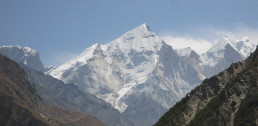
“O Sage! How can one ever do full justice to the description of the glory of Ganga and Gangottari? After obtaining a human form, one who does not perform virtuous actions related to the transcendental world lives a meaningless life like a crow. Except for a human being, which other creature is capable of reflecting on matters like this: ‘The ātma is different from the body. What happens to it after the death of the body?’ A person whose only goal is to derive greater enjoyment from food, sex etc. is to be considered animal, not a human being. One who has obtained the human form should think of what is good and what is bad and always proceed intelligently along the path that is good for him.”
“The greatest good of all that is good is firm abidance in Brahman. By giving up attachment to things and by the grace of Mother Ganga, one can attain it. Where there is no limitation of time, space etc. and no differences like ‘I’ or ‘You’, nor the duality of the ‘enjoyer’ and ‘object of enjoyment’ etc., that is the highest state of Brahman. Where there is no sun, moon or stars and no day or night, which is neither void nor non-void, that wondrous state is Brahman. That which is neither male, female nor neutral, neither with form nor formless, neither like that nor like this – that is Brahman.”
“Brahman is Truth, all else is untruth (unreal), like a dream, and not other than Brahman. This world is an appearance because of the illusion of time, place etc. The firm and direct knowledge that everything is actually Brahman alone is to be understood as the highest goal of man, one that showers the greatest bliss. Those who lack discrimination consider things which give trivial joy like women,16 gold etc. to be the highest goal.”
“As a result of past impressions (vāsanās) one may be with desires or without desires. However, by worshipping the goddess Ganga with dedication, one attains the highest state. The highest Truth is one alone, known by different names as Brahman, Īśvara, Puruşa, Siva, Vishnu, Ganga etc. In this illusory world what essence or truth is there other than Īśvara to be prayed for? Even then, out of delusion, people pray for things.”
“People should develop devotion for the Lord somehow or the other. Those who love wealth should use it to serve Him alone. The Lord grants all our desires, like the kalpataru (the wish-fulfilling tree). In whom can man17 take refuge, if not in that all-powerful Lord!”
“I am the creator of this world and my creator is the Lord who bestows all fruits of actions, the all-knowing one seated in all intellects. If power is not separate from the powerful, then Ganga is the form of the Lord alone. Mortals should take refuge in that Mother for the fulfilment of their desires.”
“Whoever reads or hears this conversation of ours about the most sanctifying Gangottari tīrtha will also attain the highest state. Bless you my son! And may the world be blessed forever!” Thus, having blessed everyone, Brahmaji became silent.
“O Ganga! O Mother! Prostrations to you! O Ganga! O Mother! Prostrations again and again! You purify the fallen and purify the pure ones too!” Thus singing the glory of Ganga Devi again and again, and prostrating to his father Brahmaji, Sri Narada left the great assembly. “Prostrations to Thee, O Fortunate One! Follower of Bhageeratha’s chariot! Prostrations to Thee, the Mother of the world! O Ganga who flows on three routes!”
This glory of the abode of the Universal Goddess Ganga, composed with the inspiration of Sri Vishveshvara, is dedicated to Lord Vishveshvara Himself. May this always please Lord Vishveshvara!
1 Also known as Ganga Gardens.
2 Locally, it is called Devaghat.
3 Variety of celestial beings.
4 Badripur.
6 This route to Mt. Kailas is known as Neelang Pass.
7 This is the place called Jangala.
8 This stream is locally known as Gungum Nala.
9 The local name is Devaghat.
10 This is called Bheemdhara.
11 Hence it is known as Mukhimatha.
12 The place is called Kachora in local parlance.
13 This is well-known to pilgrims as Harsal.
14 The local name is Kuptighat.
15 This is famous as Gharali.
16 The word ‘women’ merely refers to the joys of sex in this context. No gender discrimination is intended. Similarly, gold refers to all kinds of material wealth.
17 The word ‘man’ refers to human beings all through this composition.
Previous Topic
Nothing found.
Next Topic
Nothing found.
Home Page
Nothing found.
Through the Mists of Time
By Parvathy Raman
Pujya Gurudev Swami Chinmayananda loved and revered his Guru, Swami Tapovanji Maharaj. At every jnana yajna, he had the picture of his Guru on the stage. And Tapovanji Maharaj loved him equally well. He always replied to all the letters of his beloved disciple. It is amazing, considering how reticent and withdrawn he was in general. Every time Pujya Gurudev planned a jnana yajna in the initial years, he wrote to Tapovanji and took his blessings. The yajnas were long then, lasting for three months. And Swami Tapovan Maharaj would send messages, like the ones before the Mandukya Upanishad and Kathopanishad yajnas, which have been published here. Later, the yajna periods were reduced to suit the needs of the seekers in general and Pujya Gurudev moved from place to place, still writing to his Guru to seek his blessings regularly. When Swami Tapovan Maharaj attained mahasamadhi in January 1957, Pujya Gurudev was in Palakkad, conducting his 26th jnana yajna.
In those days, postcards were the most easily available means of long distance communication. And it was the preferred option for Swami Tapovanam, for he was a person of few words. He wrote meticulously in a neat and beautiful handwriting, using fully the limited space available in the postcard. Not a scratch or scribble is visible, though the signs of ageing and physical infirmity can be seen in the shaky handwriting of the later years.
The letters generally begin with “Dear Shri Swami Chinmayanandaji,” followed by “Om Namo Narayanaya”. Never did he take his student for granted or address him in familiar terms, shortening his name. Was it because he saw divinity alone in everyone and personal relationships faded away into insignificance? Or was it a recognition of the greatness inherent in his disciple? There is much for us to think about …
Another interesting feature of his writing is that he uses the passive voice generally. When he talks about his health, he writes as if the body is a separate entity: “Doctors have already examined the body and many medicines have already been taken. Illness is of long time. What benefit can we expect to get from such a quick visit of a doctor…” (3.9.56) In another letter dated 5.9.56, “…The body has become too weak. Even the small quantity of food of the morning also is not getting digested… In this weak condition I do not want to go anywhere, not even to Rishikesh. In this weak condition, who will serve the body there also? Talking is one thing and practising is another thing. Devotees will prepare delicious food and give us if we can eat and digest it. Nothing more they can do… And now body is not strong enough even to walk a few furlongs…” The objectivity and practical wisdom shows the extent of his detachment from his own body. The illness, pain and suffering are for the body, not for him. After all, he had dropped his identity with the body many years earlier!
The letters to and from Uttarkasi took a long time to reach their destination. In many of the letters, Pujya Gurudev has marked the date of receipt and we can see that it has taken more than a month to reach him. We can imagine Gurudev’s anxiety about the state of health of his Guru. And yet, he was a true disciple who had imbibed his Master’s wisdom. So he went on with his mission in life, teaching people yajna after yajna, with no trace of attachment that could make him deviate from his duty. Yes, genuine concern there was, and unceasing effort to take care of his Guru’s health. He kept exhorting him to see doctors and get admitted to a hospital in Delhi. To this, Swami Tapovan Maharaj replied, “Don’t people die in Delhi?”
The calm acceptance of all the travails of the body and its final destination cannot be put across with more clarity and humour. The wise disciple also understood. And yet, however wise one may be, one does grieve at the irreparable loss of the physical existence of the Guru. So did Swami Chinmayananda.
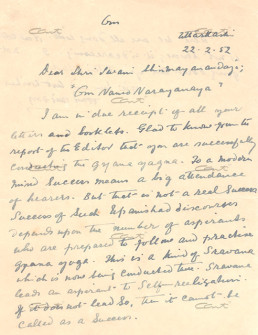
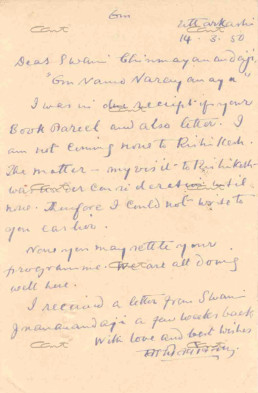


Previous Topic
Nothing found.
Home Page
Nothing found.
Song for Swami Sivananda
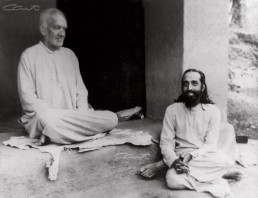
By Swami Tapovanam
On the occasion of the sixtieth birthday of Swami Sivananda Maharaj, Swami Tapovanam had composed this poem in honor of that great Mahatma. Our thanks to Swami Padmanabhananda of Divine Life Society for finding and publishing this song.

By Swami Tapovanam
On the occasion of the sixtieth birthday of Swami Sivananda Maharaj, Swami Tapovanam had composed this poem in honor of that great Mahatma. Our thanks to Swami Padmanabhananda of Divine Life Society for finding and publishing this song.
Śrī Śivānanda Şaștyabdapūrti Şațkaṁ
गुरुर्बहूनां बहुशिक्षितानां गुरुस्त्रिलोक्याश्च शिवस्वरूपः॥१॥
jīyācca jīvyācciramatra dhīraḥ śivo ya ānandakuṭīravāsī.
gururbahūnāṃ bahuśikṣitānāṃ gurustrilokyāśca śivasvarūpaḥ (1)
May this hero who is the form of blessedness and auspiciousness, the dweller of Ananda Kutir, the Guru of many learned men, the Guru of the three worlds, triumph and live long.
तद्दिव्यसज्जीवनशिक्षकोऽयं जीयान्महाचार्यवरः शतब्दान् ॥२॥
yajjīvanaṃ tīvratapaḥ prabhavāt svenānubhūtaṃ caritaṃ ca samyak .
taddivyasajjīvanaśikṣako’yaṃ jīyānmahācāryavaraḥ śatabdān (2)
May that teacher of the real divine life, that best among great preceptors, whose life has been properly lived and experienced through personal austerity of the extreme type, live for a hundred years.
जयतु जयतु विद्यौदार्यवीर्याम्बुराशिः।
जयतु जयतु भूमौ भारतज्याविभूतिर्-
जयतु जयतु दीर्घम् श्रीशिवानन्द योगी ॥३॥
jayatu jayatu jaitra śrīyutaḥ premamūrtir-
jayatu jayatu vidyaudāryavīryāmburāśiḥ.
jayatu jayatu bhūmau bhāratajyāvibhūtir-
jayatu jayatu dīrgham śrīśivānanda yogī (3)
Victory! Victory be unto the triumphant and auspicious embodiment of love! Victory! Victory be to the ocean of courage and generosity! Victory! Victory be to the wealth of Bharatavarsha! Victory! Victory be forever to yogi Sri Sivananda!
सत्यं निःस्पृहकर्म भक्तिररातिर्योगश्च तत्त्वास्थितिः।
इत्येवं विधदेवधर्ममधुरा शिक्षस्वतां स्वामिनः
शश्वत् क्लिश्यति चात्रजीवति शिवस्तातोपमस्त्वत्कृते ॥४॥
re re mānuṣa daivasaṃpadiha yā mokṣapradā dehināṃ
satyaṃ niḥspṛhakarma bhaktirarātiryogaśca tattvāsthitiḥ.
ityevaṃ vidhadevadharmamadhurā śikṣasvatāṃ svāminaḥ
śaśvat kliśyati cātrajīvati śivastātopamastvatkṛte (4)
O Man! Real divine wealth which bestows final liberation on the embodied ones here is fourfold: disinterested service, devotion, yoga and knowledge of the Reality. Acquire this precious divine wealth from Swami Siva, for he like a father, is ever troubling himself throughout his life for your sake.
धन्या सा द्राविडी भू ऋषिमुनिजननी भारती चापि धन्या।
धन्या कुब्जाम्रकाभूरथ तुहिनगिरिः स्निग्धकाश्चास्मदाद्या
लब्धो यस्मादिनोद्यद्दयुति शिवयतिसंपर्कसौभाग्यलाभः॥५॥
dhanyā mātā ca dhanyaṃ kulamatha taṭinī tāmraparṇī ca dhanyā
dhanyā sā drāviḍī bhū ṛṣimunijananī bhāratī cāpi dhanyā.
dhanyā kubjāmrakābhūratha tuhinagiriḥ snigdhakāścāsmadādyā
labdho yasmādinodyaddayuti śivayati-saṃparka-saubhāgya-lābhaḥ (5)
Blessed is (his) mother. Blessed is (his) family. Blessed is the river Tamraparni. Blessed is the Tamil country. Blessed is Hindustan
(Bharata), the mother of saints and sages. Blessed is Rishikesh. Blessed is the Himalayas. Blessed are friends (of his), like me, who
have gained the joy of the company and intimacy with Swami Sivananda, whose light is just like the light of the rising sun.
श्चादिष्टं यद्वरिष्ठं सुखपदमभयं जीवनं दिव्यमेकम्।
लोके तद्वृद्धिहेतोस्तदभिनव गुरोर्जीवनं श्रीशिवेन्द्र-
स्यारोग्यं चापि दीर्घम् जनधननिचयं हे नराः प्रार्थयध्वम् ॥६॥
lakṣyaṃ kāṃkṣyaṃ narāṇāṃ nikhilamunivarairvedikairvedabāhyai-
ścādiṣṭaṃ yadvariṣṭhaṃ sukhapadamabhayaṃ jīvanaṃ divyamekam.
loke tadvṛddhihetostadabhinava gurorjīvanaṃ śrīśivendra-
syārogyaṃ cāpi dīrgham janadhananicayaṃ he narāḥ prārthayadhvam (6)
The aim and the object of man here, as declared by all sages of the Vedic and non-Vedic periods, the best, peace bestowing, peerless life is one, and that is divine. To propound the glory of this divine life, its new teacher, Sri Sivananda exists here. For his long life and for his disciples and workers, pray now, O men on earth!
Previous Topic
Nothing found.
Next Topic
Nothing found.
Home Page
Nothing found.
Editors Note - Dec 2011
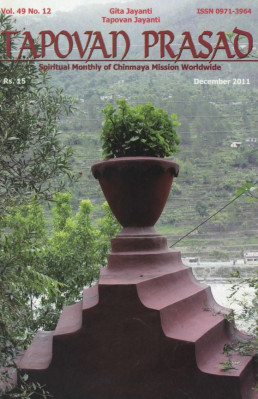
Showers of Satsang
On the eve of our Golden Jubilee Year, we seek our Paramaguru Swami Tapovan Maharaj’s blessings by dedicating the entire issue to him. When we began compiling the issue, we decided to focus on some of his little known writings and hitherto unpublished manuscripts. My worries about the paucity of new material were set to rest as letters and articles started flowing in from unexpected quarters. I came upon a hitherto unknown article by Swami Tapovanji on Swami Sivananda Maharaj. Brni. Prarthana Chaitanya (Swamini Kaivalayananda), who was collecting Pujya Gurudev Swami Chinmayananda’s letters and other documents under instructions from Pujya Guruji Swami Tejomayananda, found a treasure trove in Kerala – letters by Swami Tapovan Maharaj, a shraddhanjali souvenir and some other documents. Both of us were excited and worked hard, racing against time to share as much of it as possible with our readers, as the magazine deadlines were looming large. We realised that Sri Tapovanji Maharaj was showering his blessings upon us. Our hearts are full as this magazine goes to the press and I am sure all our readers will experience the same as they traverse through the pages of precious manuscripts, articles and letters.

Showers of Satsang
On the eve of our Golden Jubilee Year, we seek our Paramaguru Swami Tapovan Maharaj’s blessings by dedicating the entire issue to him. When we began compiling the issue, we decided to focus on some of his little known writings and hitherto unpublished manuscripts. My worries about the paucity of new material were set to rest as letters and articles started flowing in from unexpected quarters. I came upon a hitherto unknown article by Swami Tapovanji on Swami Sivananda Maharaj. Brni. Prarthana Chaitanya (Swamini Kaivalayananda), who was collecting Pujya Gurudev Swami Chinmayananda’s letters and other documents under instructions from Pujya Guruji Swami Tejomayananda, found a treasure trove in Kerala – letters by Swami Tapovan Maharaj, a shraddhanjali souvenir and some other documents. Both of us were excited and worked hard, racing against time to share as much of it as possible with our readers, as the magazine deadlines were looming large. We realised that Sri Tapovanji Maharaj was showering his blessings upon us. Our hearts are full as this magazine goes to the press and I am sure all our readers will experience the same as they traverse through the pages of precious manuscripts, articles and letters.
Next Topic
Nothing found.
Related Topic
Nothing found.
Home Page
Nothing found.
Reminiscences

By Swami Chinmayananda
This is an article penned by Pujya Gurudev where he fondly shares some memories of his Guru, Swami Tapovan Maharaj. This article was published in the December 1971 edition of Tapovan Prasad.

By Swami Chinmayananda
This is an article penned by Pujya Gurudev where he fondly shares some memories of his Guru, Swami Tapovan Maharaj. This article was published in the December 1971 edition of Tapovan Prasad.
Here, when I am lying helplessly under treatment in the clinic, my thoughts wander away to Tapovan Kuti on the Ganges banks in Uttarkasi and to the period when I was doing my sadhana there. In this peculiar mood of relaxed memories, many remarkable anecdotes of Sri Gurudev (Swami Tapovanam) explode in my recollections. It is surprising how in my continuous preoccupation with my self-chosen missionary work, I had, all these years, forgotten the brilliant flashes of Sri Gurudev’s ready wit and sparkling wisdom.
I don’t exactly remember the specific occasions that brought up these live examples from him, but each one of them was a glorious answer to some question, or a blazing explanation of some moot point in higher Vedanta.
Once upon a time, described Sri Gurudev, a secular tyrant made a Mahapurusha hang from the branch of a tree by his teeth. Down below flowed the noisy Ganga, smashing her way through a bed of large rocks. At that time a seeker asked, “Sir! Tell me the nature of the Infinite Self.” If the Mahapurusha opened his mouth either to assert or to negate the Self, he would dash himself into the rocky floods; if he remained silent, the student would be neglected, which was against the Mahatma’s sole duty in life. How would he express?
“It is then,” concluded Sri Tapovanam “perhaps, that the Master showed the student the jnana mudra, meaning that the Self is not to be discussed. It is to be realised by oneself in the silence within.” Both assertion and negation are functions of the intellect. Beyond them both is the transcendental Self, the seat of pure Consciousness.
व्यवहार्यमग्राह्यम अलक्षणमचिन्त्यमव्यप-देश्यमेकात्मप्रत्ययसारं प्रपञ्चोपशमं शान्तं
शिवमद्वैतं चतुर्थं मन्यन्ते स आत्मा स विज्ञेयः॥
nāntaḥprajñaṃ na bahiṣprajñaṃ nobhayataḥprajñam na prajñānaghanaṃ na prajñaṃ nāprajñam. adṛṣṭama-
vyavahāryamagrāhyam alakṣaṇamacintyamavyapa-deśyamekātmapratyayasāraṃ prapañcopaśamaṃ śāntaṃ
śivamadvaitaṃ caturthaṃ manyante sa ātmā sa vijñeyaḥ..
It is not that which is conscious of the internal subjective world, not that which is conscious of the external world, not that which is conscious of both, nor that which is a mass of Consciousness, nor that which is simple Consciousness, nor is it unconscious. It is unseen by any sense organ, unrelated to anything, incomprehensible by the mind, uninferrable, unthinkable, indescribable, essentially of the Self alone, negating all phenomena; it is peaceful, all bliss and non-dual. This is what is known as the fourth (turiya). This is the Atman and this is to be realised.1
“A Vedantic teacher was once approached by a mahatma one afternoon,” said Sri Gurudev, “asking him with all reverence, ‘Explain to me, sir, the nature of the Self.’”
“The great master looked at the young monk, winked at him and said, ‘I will tell you all about it when there is no one here.’
“After a time, the anxious and sincere mahatma reached the teacher and reminded him, ‘Now there is nobody here, sir. Please instruct me.’ The Vedantic teacher did not open his eyes, nor did he reply. The mahatma waited for some time, and thinking that perhaps the teacher had not heard, repeated the request.
“The Vedantic saint smiled and said, ‘Not now. Let everyone go away.’
’Sir, everyone has gone; there is nobody here. I am alone here,’ asserted the student.
‘So long as you are here,’ snap came the answer, ‘how can I tell the Truth?’
“Where the ego has ended, and the clamour of all thoughts has been entirely hushed up, in that ‘living-silence’ is the self realised,” concluded Sri Gurudev. I was immature then. From immaturity springs all the audacity of fools. So I asked, “Sir, who is it in the mahatma that knows that there is nobody there?”
Like lightning came the reply: “That, even the wisest do not know.” The vigour and suddenness of the reply then satisfied me. Only now I realise the wisdom of the ready reply. The Self is never an object for anyone’s intellectual appreciation as knowledge.
yato vāco nivartante aprāpya manasā saha
That from which speech and mind return, unable to reach or apprehend — that is the supreme state of the Self.2
Once, a young man came all the way from Sri Gurudev’s native village in Kerala. This man must have rushed out of his home in a moment of economic crisis. However, he had deep devotion and an ardent sense of reverence towards Sri Gurudev. He announced himself as a distant relative of Sri Swami Tapovanam and narrated non-stop the present welfare and well-being of various members of the ‘family’ in Kerala, in its various ‘branches’.
All the time — it was more than an hour — Swamiji sat, listening to the music of the roaring Ganges. Now and then he gave an encouraging and indulgent “Hm… Hm… Hm…” to the young man’s unilateral bombardment.
In the stream of his empty talks, he mentioned his present state of need and poverty. Finally, as an apology for coming without some gift, he said, “What would you say if I came to you empty-handed!”
Snap came the answer from Sri Gurudev, “Drop it down.”
But the noisy speaker, in his incorrigible innocence, went on, “I said, if I came to you really empty-handed?”
The answer shot out from Sri Gurudev, “Then gather and carry away as much you can!!”
When the mouth is noisy, little do we understand what others say, and much less can we comprehend what our mystic masters indicate with their rare words.
The young man understood nothing. He grinned, and Swamiji with a knowing look at me, smiled at the visitor. The visitor was consoled. He must have considered it as some joke Swamiji had cracked, which of course, he could not understand! The young man from Kerala continued his reports of his native village. Swamiji, still smiling, moved his eyes from the visitor to the refreshing flow of the ever-pure mother Gangaji!! Only empty hands can gather and carry away even when given freely by another.
1 Mandukya Upanishad, 7
2 Taittiriya Upanishad, 2.9
Previous Topic
Nothing found.
Next Topic
Nothing found.
Home Page
Nothing found.
